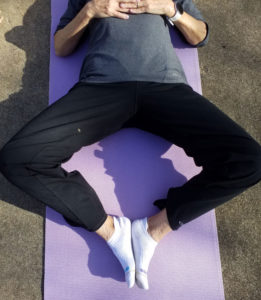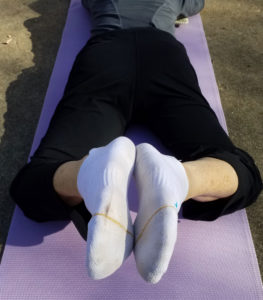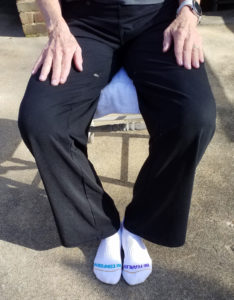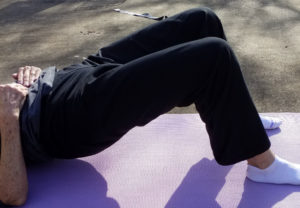Butt pain – Isometric Exercises

“Butt Pain.” has different tissue diagnoses. Possible diagnoses are sciatica; piriformis syndrome; gluteal tendinopathy; hamstring tendinopathy; bursitis; hip arthritis; and others.
There are many treatments for butt pain. My “go-to” exercise for butt pain is isometric contractions of the gluteal muscles.
In my experience rarely is trying to “stretch it out” effective treatment for butt pain.
More often “pump it up” is a more effective treatment for butt pain.
A mainstay of therapy for musculoskeletal pain syndromes has been isometric strengthening exercises. These strengthening exercises became popular in the 1920s because of promotion by celebrity bodybuilder Charles Atlas. Isometric exercises are a type of strengthening exercise in which the muscle is contracting but there is no movement of the joint. It is exerting a force with no movement.
Isometric strengthening exercises for butt pain is analogous to aspirin. Aspirin is a common treatment for different diagnoses. Aspirin has many effects including decreasing fever; reducing pain; reducing swelling; decreasing the risk of blood clots. Isometric strengthening exercises common treatment for different of different tissue diagnoses associated with butt pain. Isometric strengthening exercises has many effects listed below:
- Pain reduction - isometric exercise has a pain-relieving effect for tendon problems. The reduced pain can be immediate and can last for 4 to 8 hours after isometric exercise.
- Positive adaptations of tendons – the muscle tendon-unit gets bigger, thicker, and stronger
- Improve neuromuscular recruitment and firing of the muscle fibers.
- Neurological changes – improve coordination and faster rate of force development, increasing explosive power
- Facilitating proper positioning and alignment of your hips and legs when performing more advanced hip exercises. Isometric exercises are a starting point and foundation for more advanced strengthening exercises.
- Improving performance in activities of daily living and athletic performance.
- Facilitating positive changes in joint fluids. Pumping, moving, distributing normal synovial fluids around the joint surfaces is beneficial in managing osteoarthritis.
When is the best time to use an isometric strengthening exercise? Any time is suitable time to practice isometric exercises. Because there are no movements of joints, and the magnitude of forces are under voluntary control they are safe early in recovery from injury or surgery. A suitable time to perform isometric exercises when there is pain.
What is the best position to perform the isometric exercise? It has been shown the compressive loads on tendons contribute to tendon pathologies. According to Allison Grimaldi and colleagues, the combination of excessive compression and high tensile loads within tendons is thought to be most damaging. Jill Cook and others suggest that isometric exercises should be done in a position when the tendons are not compressed across boney prominence.
The position where the hip joint has the least compressive and tensile load is a slight amount of hip flexion, a slight amount of hip abduction, and slightly externally rotated (loose pack position, rest position). This position avoids tendon compression, provides for space between the joint surfaces to allow movement of joint fluid.
Gluteal tendons are under increased compressive and tensile load when sitting. As proficiency with isometric exercises in neutral joint position is achieved the positions can be progressed to performing isometric gluteal muscle contractions while sitting. Isometric gluteal muscle contractions can be practiced while sitting in a car waiting at a stoplight.
How intense should the isometric contraction be? The intensity can be titrated based on the perceived level of pain. There is an ongoing debate whether isometric contraction exercises should be below the level of pain, at the level of pain, or beyond the pain threshold?
According to Peter Malliaras and colleagues’ isometric contractions should be heavy to effectively achieve pain relief.
Typically butt pain only occurs on one side of the body. Performing a maximum isometric contraction on the uninvolved side provides a benchmark or standard to compare with the involved painful butt side.
What does it feel like to perform a maximum effort to contract the butt muscles on the non-painful side? How full does it feel? How quickly does it fill? Compare the sensation between the non-painful side to the painful side. Often the painful side feels less engaged, less full, smaller in size, slower to reach the maximum. The goal is to achieve symmetry to feel the same degree of fullness, size, speed, and precision in the painful butt as there is in the non-painful butt.
Rafael Escamilla and colleagues suggest isometric contraction needs to be at least 40% of a maximal isometric contraction to achieve strength gains. Use the non-pain butt maximum contraction to determine what a 100% is.
How precise should the isometric contraction be? The gluteal muscles and hamstring muscles work in synergy. The timing of the recruitment or activation can vary between synergistic muscles. Individuals will activate the hamstring before activating the gluteal muscles. Individuals will activate the hamstring and gluteal muscles at the same time. The theory is that engaging activating both hamstring and gluteal muscles at the same time is optimal. When the hamstrings activate before the gluteal muscles it is “hamstring dominant.” Hamstring dominance increases the risk of overuse injuries and butt pain.
When performing isometric exercises for butt muscles aim to differentiate the activation and contraction of the hamstring muscles from the gluteal muscles. It takes time to practice and focuses to learn how to activate the gluteal muscles at the same time as the hamstrings. Better yet, strive to isometrically activate the gluteal muscles without engaging or contracting the hamstrings.
How long should an isometric contraction exercise be? There is little consensus regarding the optimal length of contraction. Ebonie Rio and colleagues suggest five repetitions of forty-five-second contractions as a starting point. My recommendation is to practice isometric contractions of various durations, 5 seconds, 45 seconds, and/or minutes. Strive to hold a firm butt muscle isometric contraction for the duration of a stoplight when driving.
How frequent should the isometric exercise be? There is little consensus regarding the optimal frequency of isometric contraction exercises. If you are performing the isometric contraction exercise precisely you cannot do it frequently enough. There is little if any risk of overdosage using isometric strengthening exercises. This exercise can be your go-to first aid if you are experiencing buttock pain sitting or standing.
Below are images & descriptions of optimal positions to perform isometric exercises for gluteal muscles commonly called “Glute Sets”
The isometric exercises can be the right side and left side simultaneous, one side then the other, then one side alone. Eventually, repeat and practice the painful side alone.
Lying down face up or face down:
- Lying face up with a pillow under knees, hips slightly flexed, knees apart, toes point outward or lying on belly pillow under ankles so knee is slightly flexed, knees apart, toes pointing outward.
- Tense, contract engage the deep gluteal muscles at the side of the hip. You should feel deep gentle tension at the side of the hips/buttocks
- Initially strive to feel the contraction in buttock muscles at the same time as the hamstrings. Progress to feeling the contraction in the buttock muscles without contracting the hamstring muscles.
Standing:
- Standing with feet wider than hips, knees slightly bent, feet/toes turned outward.
- Leaning back against a wall or countertop so you can feel the buttock muscles pressing into a firm surface.
- Leave your feet still
- Slowly and gently imagine you are going to slide your legs apart – imaginary splits.
- Tense contracts engage the deep gluteal/buttock muscles as the sides of the hip.
- You should be aware of a deep gentle tension at the side of the hips/buttocks.
Lying down frog position face up or face down:
- Lay face down or face up with knees apart and bent. Allow hips to rotate so feet touch. Legs are in a frog position.
- Push feet together by isometrically tightening contracting the buttock muscles.
- Tense, contract, engage the deep gluteal/buttock muscles at the side of the hips. You should feel deep gentle tension at the sides of the hips/buttocks.
- Initially strive to feel the contraction in buttock muscles at the same time as the hamstring muscles. Progress to feel the contraction in the buttock muscles without contracting the hamstring muscles.


Sitting frog position:
- Sitting recline backward
- Allow hips to spread and rotate with knees wide apart so feet can touch – frog position
- Push feet together by isometrically tightening contracting the buttock muscles.
- Tense, contract, engage the deep gluteal/buttock muscles at the sides of the hips. You should feel deep gentle tension at the side of the hips/buttocks.
- Initially strive to feel the contraction in buttock muscles at the same time as the hamstrings. Progress to feel the contraction in the buttock muscles without contracting the hamstring muscles.

Supine butt lift bridging:
- Lying face up feet and knees shoulder-width apart, bend knees, feet flat on supporting surface.
- Draw in and engage your lower abdominal muscles gently.
- Tense, contract, engage your gluteal/buttock muscles on the sides of the hips without tucking or tilting your pelvis.
- Press heels into supporting surface, keep toes relaxed.
- Lift pelvis off supporting surface. Only lift in a comfortable range, this may be only just enough to take pressure off your buttocks initially.
- There should be no discomfort in the lower back
- Lift up slowly and down as slowly as you lift, work the gluteal/buttock muscles all the way.
- Ensure your focus is on your gluteal/buttock muscles. Do not let your hamstrings take over. If you are getting cramps in the hamstrings, you are hamstring dominant and the gluteal/buttock muscles are not doing enough work. Try positioning your feet closer to your buttocks. If hamstrings continue to cramp revert back to the above exercises.

Pain in the butt, build up the butt.
Don’t be a half-ass be a complete ass
The information on this website is not intended or implied to be a substitute for professional medical advice, diagnosis, or treatment. You are encouraged to perform additional research regarding any information contained available through this website with other sources and consult with your physician.
Damien Howell Physical Therapy – 804-647-9499 – Fax: 866-879-8591 At-Home, At Office, At Fitness Facility – I come to you, I do home visits Damien@damienhowellpt.com
